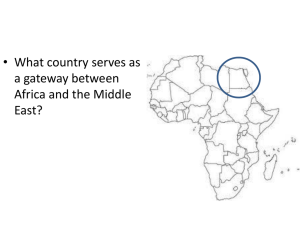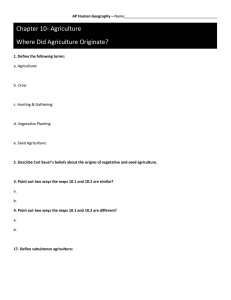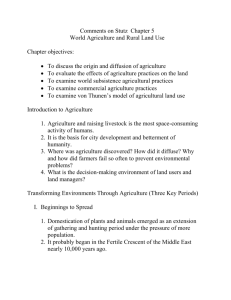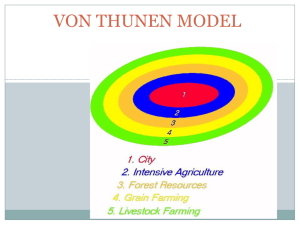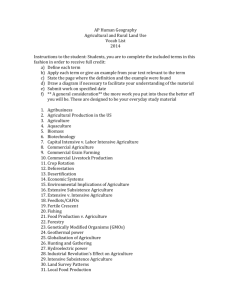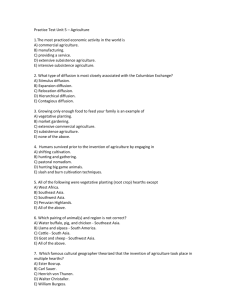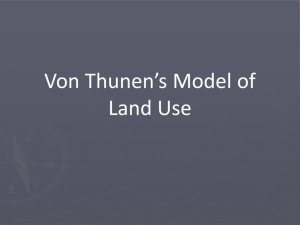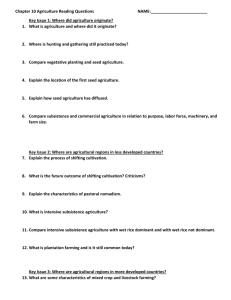AP Human Geography Name: Unit 5 Test Copeland Due Date
advertisement
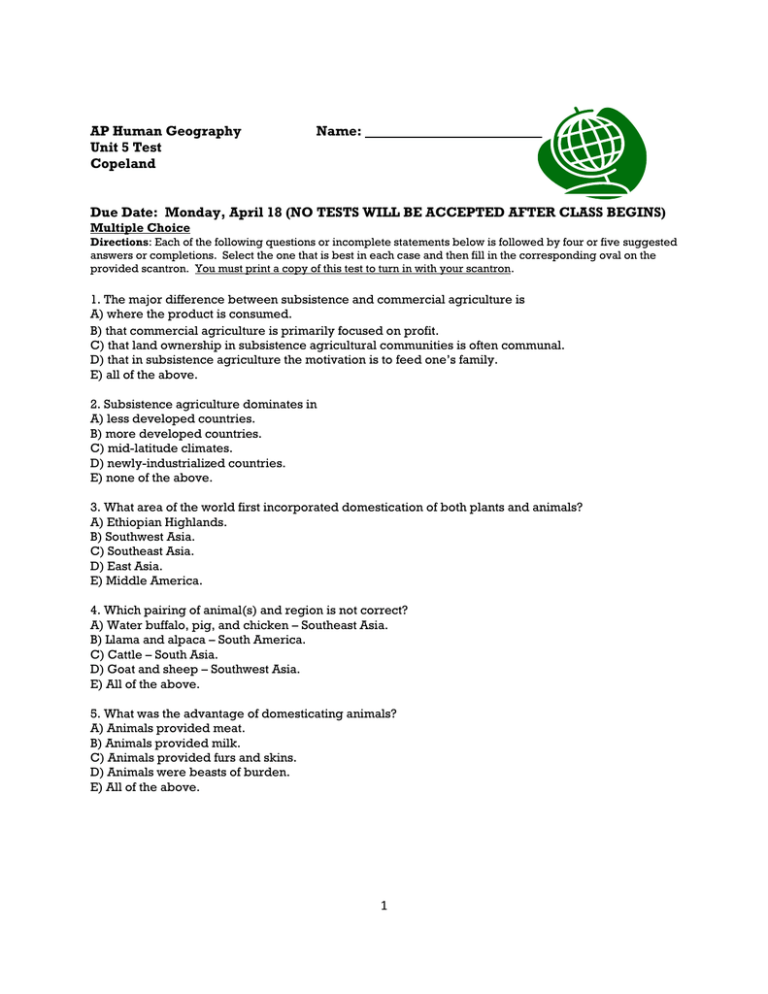
AP Human Geography Unit 5 Test Copeland Name: Due Date: Monday, April 18 (NO TESTS WILL BE ACCEPTED AFTER CLASS BEGINS) Multiple Choice Directions: Each of the following questions or incomplete statements below is followed by four or five suggested answers or completions. Select the one that is best in each case and then fill in the corresponding oval on the provided scantron. You must print a copy of this test to turn in with your scantron. 1. The major difference between subsistence and commercial agriculture is A) where the product is consumed. B) that commercial agriculture is primarily focused on profit. C) that land ownership in subsistence agricultural communities is often communal. D) that in subsistence agriculture the motivation is to feed one’s family. E) all of the above. 2. Subsistence agriculture dominates in A) less developed countries. B) more developed countries. C) mid-latitude climates. D) newly-industrialized countries. E) none of the above. 3. What area of the world first incorporated domestication of both plants and animals? A) Ethiopian Highlands. B) Southwest Asia. C) Southeast Asia. D) East Asia. E) Middle America. 4. Which pairing of animal(s) and region is not correct? A) Water buffalo, pig, and chicken – Southeast Asia. B) Llama and alpaca – South America. C) Cattle – South Asia. D) Goat and sheep – Southwest Asia. E) All of the above. 5. What was the advantage of domesticating animals? A) Animals provided meat. B) Animals provided milk. C) Animals provided furs and skins. D) Animals were beasts of burden. E) All of the above. 1 6. Which famous cultural geographer theorized that the invention of agriculture took place in multiple hearths? A) Ester Bosrup. B) Carl Sauer. C) Henrich von Thunen. D) Walter Christaller. E) William Burgess. 7. Shifting cultivation is a threatened form of agriculture because of A) competition for resources from logging and mining companies. B) population increase. C) modern technology makes the practice obsolete. D) A and B only. E) none of the above. 8. All of the following are characteristics of shifting cultivation except A) people usually live in small villages. B) farmers clear land using a slash (vegetation) and burn (debris) technique. C) crops are grown on land until the nutrients in the soil are depleted. D) primogentric land ownership dominates shifting cultivation societies. E) farmers usually return to the same area approximately twenty years later. 9. Pastoral nomads predominate in A) semi-arid deserts. B) deserts. C) subtropical grasslands. D) tropical rainforest. E) A and B only. 10. Herders who seasonally move their animals between mountain pastures and lowland valleys practice A) transhumance. B) seasonal variation. C) swidden agriculture. D) livestock ranching. E) extensive subsistence agriculture. 11. Pastoral nomads potentially contribute to desertification by A) overgrazing. B) using poor cultivation techniques. C) moving animals frequently. D) all of the above. E) A and B only. 12. The agricultural practice most commonly associated with intensive subsistence agriculture is A) paddy rice farming. B) swidden agriculture. C) plantation agriculture. D) market gardening. E) none of the above. 2 13. What geographic factor best explains why a piece of land is used intensively or extensively for agriculture? A) Soil quality. B) Precipitation levels. C) Climate region. D) Distance to the market. E) Price of land. 14. Which region is not a major dairy producing area? A) Southeast Canada. B) Northeastern United States. C) Southern California. D) Northwestern Europe. E) Southeast United States. 15. Dairy farmers specialize in other products rather than fresh milk because A) of the low profit margin of milk. B) they are located outside the milkshed. C) of the high cost of feed. D) of the high cost of land. E) none of the above. 16. Grain produced in the United States is used for all of the following except it is A) purchased by food processing companies for baked products. B) sent around the world as foreign aid. C) stored in grain elevators for and sold in the market when prices increase. D) consumed predominately by local communities throughout the Midwest. E) sent to sub-Saharan Africa for famine relief. 17. The country that produces the most maize in the world is A) Canada. B) United States. C) Ukraine. D) Brazil. E) Argentina. 18. The two most important crops grown in the Mediterranean region are A) dates and lemons. B) almonds and grapes. C) grapes and olives. D) olives and tomatoes. E) wheat and olives. 19. What is the best reason why market gardening farms grow highly perishable fruits and vegetables? A) Favorable climate. B) High soil fertility. C) Farms are located close to urban centers. D) Transportation costs are low. E) Government subsidies make it possible. 3 20. According to the von Thunen model, what type of agricultural practice would locate in the outer most concentric ring? A) Dairy. B) Forestry. C) Grazing. D) Mixed crop and livestock. E) Horticulture. 21. Why did von Thunen include a forestry ring in his model of agricultural land use? A) Wood was quickly becoming a scarce resource. B) Wood was used for construction purposes and heating. C) Wood is heavy and therefore expensive to transport. D) Wood was a sustainable product. E) B and C only. 22. According to the von Thunen model, the first ring is used for A) dairy. B) forestry. C) mixed crop and livestock. D) crop rotation. E) grain farming. 23. Using von Thunen’s model as a basis for analysis, assume New York City is the single market for the United States, market gardening would be located in A) the upper Midwest. B) California. C) Pacific Northwest. D) New England. E) southeastern states. 24. Using von Thunen’s model as a basis for analysis, assume New York City is the single market for the United States, mixed crop and livestock agriculture would be located in A) New England. B) the Midwest. C) the Pacific Northwest. D) southeastern states. E) Great Plains. 25. von Thunen’s agricultural land use model assumes A) there is a flat isotopic plane. B) there are uniform soils across the landscape. C) there are no physical features present, such as rivers or mountains. D) all goods use the same form of transportation. E) all of the above. 26. The linear agricultural land use pattern commonly found in Quebec and Louisiana is A) the long lot system. B) the range and township land survey system. C) the metes and bounds land ownership method. D) a result of the Enclosure Movement. E) none of the above. 4 27. The region of the world that benefited the least from the Green Revolution was A) South Asia. B) East Asia. C) South America. D) Sub-Saharan Africa. E) Central America. 28. The trend whereby large corporations buy and control many different steps in a food-processing industry is commonly referred to as A) agribusiness. B) biotechnical revolution. C) industrial agriculture. D) all of the above. 29. The two most widely used and distributed Genetically Modified Organisms (GMO) crops are A) corn and wheat. B) wheat and millet. C) soybeans and wheat. D) soybeans and corn. E) corn and flax. 30. Which of the following agricultural practices could be deemed sustainable? A) Intensive subsistence. B) Organic truck farming. C) Commercial livestock feedlots. D) Commercial dairy operations. E) A and B only. 31. ____________has increased its production by 20% per year for the last twenty years. A) Sustainable agriculture. B) Viticulture. C) Organic agriculture. D) Chicken production. E) None of the above. 32. Due to over harvesting of fish stocks and increased demand for seafood, what form of agriculture has substantially grown in the last thirty years? A) Factory deep sea fishing. B) Commercial plantation agriculture. C) Agribusiness. D) Aquaculture. E) Monoculture. 33. In the last twenty years the region of the world that has experienced a decline in food production compared to population growth is A) South Asia. B) Southeast Asia. C) Sub-Saharan Africa. D) Central America. E) East Asia. 5 34. The region with the lowest percent of the labor force directly engaged in agriculture is A) Western Europe. B) North America. C) Eastern Europe. D) North Africa. E) East Asia. 35. A large, self-propelled agricultural machine used to harvest grain crops A) corn husker B) combine C) reaper D) hoe 36. The most common form of beef cow in the United States: A) Holstein B) Jersey C) Angus D) Chick-fil-A 37. The most common varieties of oranges grown in the United States are (mark both) A) Valencia B) Cuties C) Navel D) Helvetica 38. What are the three leading coffee producers in the world? A) India, Mexico, Guatemala B) Honduras, Brazil, Ethiopia C) Brazil, Vietnam, Indonesia D) Colombia, Uganda, India 39. All of the following are major corn producers in the United States except A) Iowa B) Nebraska C) Oklahoma D) Indiana E) Minnesota 40. Which of the following has led to the creation of at least nine different species of weeds? A) Shifting agriculture B) Slash and burn agriculture C) Genetically engineered crops D) Green Revolution 41. Which of the following was a response to the Green Revolution? A) fish farming B) intensive subsistence agriculture C) creation of the combine D) organic farming E) all of the above 6
